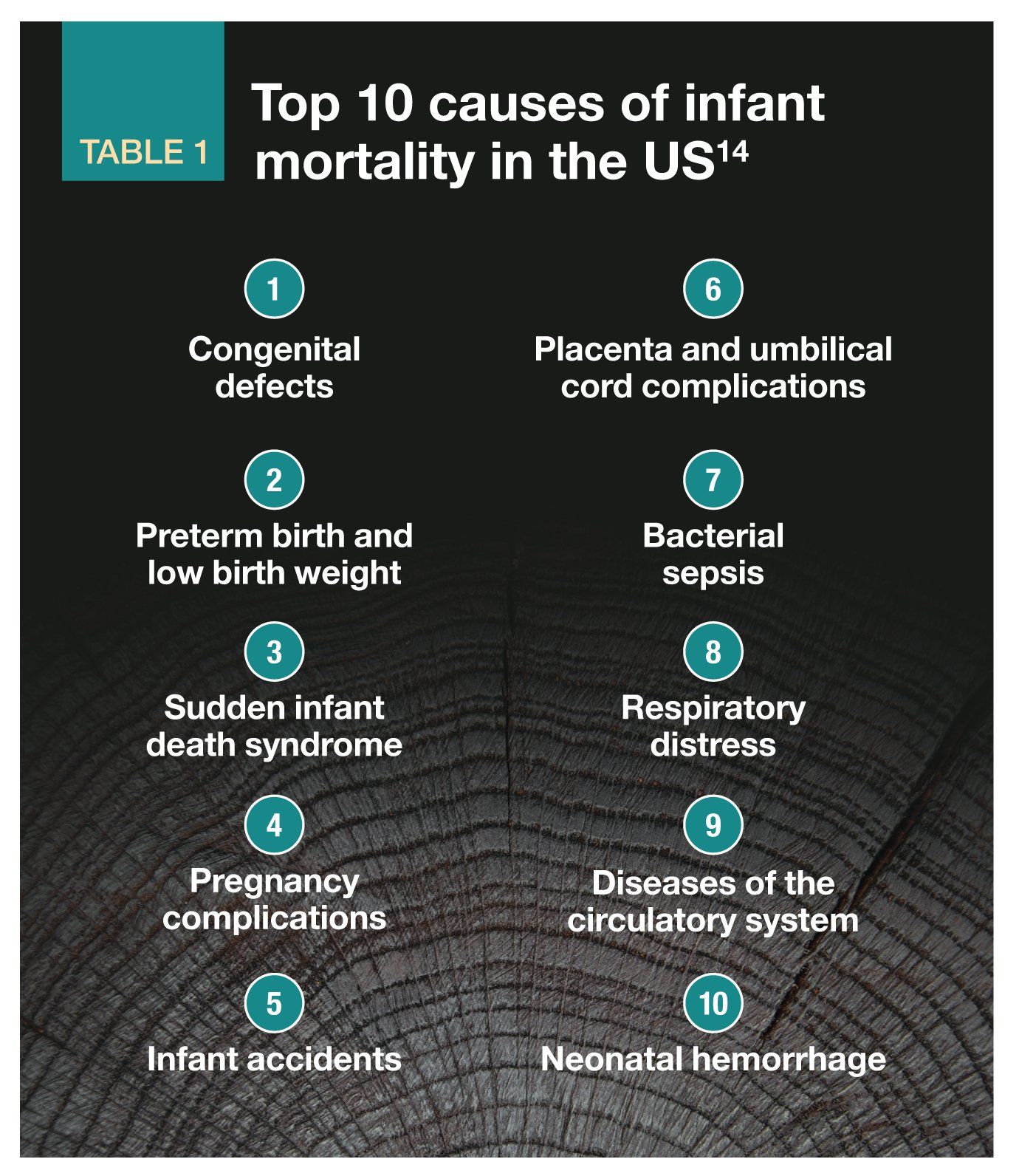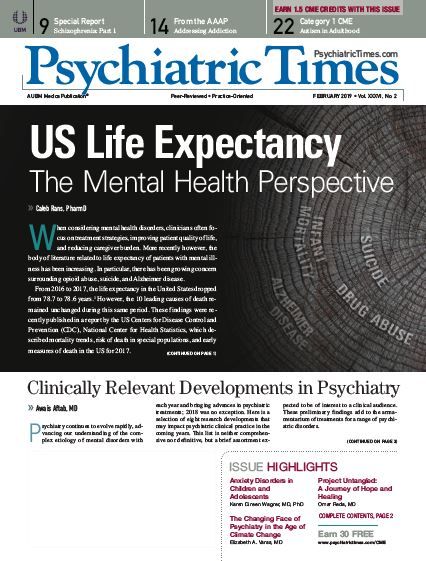Publication
Article
Psychiatric Times
US Life Expectancy: The Mental Health Perspective
Author(s):
Opioids, suicide, and Alzheimer disease all play a large role in the life expectancy drop reported by the CDC.
Table. Top 10 causes of infant mortality in the US

When considering mental health disorders, clinicians often focus on treatment strategies, improving patient quality of life, and reducing caregiver burden. More recently however, the body of literature related to life expectancy of patients with mental illness has been increasing. In particular, there has been growing concern surrounding opioid abuse, suicide, and Alzheimer disease.
From 2016 to 2017, the life expectancy in the United States dropped from 78.7 to 78.6 years.1 However, the 10 leading causes of death remained unchanged during this same period. These findings were recently published in a report by the US Centers for Disease Control and Prevention (CDC), National Center for Health Statistics, which described mortality trends, risk of death in special populations, and early measures of death in the US for 2017.
J. John Mann, MD, from the department of psychiatry at Columbia University in New York, told Psychiatric Times, “We [only] have data from the CDC for 2017 and no later.” Data from the mortality report are compiled into a computerized database, known as the National Vital Statistics System, which contains death certificates from all 50 states and the District of Columbia. Researchers use statistical techniques to generate population-based reports from these records and the findings are released annually by the CDC.
Mortality patterns among US residents were analyzed by sex, race, ethnicity, and cause of death. The 2017 data indicate that life expectancy decreased primarily due to increases in mortality from unintentional injuries, suicide, diabetes, and influenza and pneumonia.
Opioid/prescription drug abuse
Since the turn of the 20th century, opioid misuse in the US has been increasing.2 Current evidence has shown this trend is not restricted to one particular demographic group; however some groups exhibit higher risk than others, including males, Medicaid recipients, and those with past substance use disorders. Furthermore, unsafe injection methods, such as reusing and sharing contaminated needles, are common practices among individuals who misuse opioids.
According to the CDC, deaths due to drug overdose reached a record high this past year, with over 70,000 deaths reported in 2017.3 The number of deaths that involved synthetic opioids, adjusted for age, excluding methadone, rose by 45% between 2016 and 2017. Specific agents in this class include tramadol, fentanyl, and other fentanyl analogues, which are often abused via precarious injection practices.
The CDC reported, “Deaths from drug overdose continue to be a public health burden in the United States. . . . In 2017, among persons aged 15 and over, rates were highest for adults aged 25 to 34 and 35 to 44 at 38.4 and 39.0 per 100,000, respectively.”1
It is estimated that nearly 4% of adults in the US misuse prescription opioid analgesics.4 Furthermore, thousands of Americans die each year due to illicit opioid use. Several key stakeholders are concerned about opioid overprescribing, noting that few clinicians obtain sufficient opioid-specific prescribing training.
When considering a practical solutions to resolve the opioid epidemic, several strategies have been proposed, including improving accessibility to medication-assisted therapies, such as naltrexone and buprenorphine, using abuse-deterrent drug designs and adhering to evidence-based prescribing guidelines.
Given that millions of Americans are struggling with chronic pain, developing effective non-opioid analgesics is another strategy. Further research to increase our knowledge of the biological mechanisms that mediate pain is essential to produce lasting solutions.
Suicide
On a global scale, the World Health Organization (WHO) estimates that nearly 800,000 people die because of suicide each year.5 Unfortunately, because the absence of adequate recording systems and the complexities of administrative procedures related to suicide death registration, the exact figure remains largely undetermined. Furthermore, approximately 80% of suicides occur in nations with inadequate public health services, and limited access to mental health resources.
Between 2016 and 2017, the suicide rate in the US increased by 3.7%.1 The surge in suicides was seen predominantly in one group-young adults aged 21 to 34 years.6 The incidence also increased in youths ages 9 to 14 years. Other characteristics linked with this increase were persons who had a history of violence, adults with anxiety and depressive disorders, and persons with lower socioeconomic status.
Gun-related suicides are a large part of the suicide statistics. The 2015-2016 rise in firearm suicides continued a 10-year trend, according to the CDC. From 2006 to 2016, suicides by firearm increased 21%, after declining 7% from 1999 to 2006.7
Numerous solutions have been suggested to prevent suicide-related mortality, including effectively treating depression and other mental health disorders, which are significant risk factors for suicide. In addition, restricting access to firearms and pesticides, which are common methods used, may result in fewer completed suicides. Internationally, increasing awareness around suicide prevention and implementing suitable data registration programs are key goals for the future.
Alzheimer disease
Another area of concern is rising mortality in patients with Alzheimer disease (AD), which after adjusting for age, rose 2.3% from 2016 to 2017.1 This disease affects more than 5 million Americans each year. AD has a particularly severe impact on persons afflicted with the disease, their caregivers, and society, which is largely attributable to the significant costs associated with care.8 With no existing disease-altering treatment options, and few drugs to manage symptoms, prevention strategies are key to reducing the morbidity and mortality of this condition.
Clinicians and researchers are searching for better strategies to manage AD.9 Recent advances in biomarker technology have transformed the way the disease is diagnosed. Using specific biomarkers, such as measures of brain volume and amyloid plaque levels, clinicians are now able to differentiate AD from other dementias.
Current preventative strategies for AD involve lifestyle modifications and other risk reduction approaches.8 These modifications include eating a healthy and balanced diet, high in vegetables, fruits, fish, and olive oil.10 Recent findings suggest that these foods contain high levels of unsaturated fatty acids, polyphenols, and vitamins, which exhibit positive effects on disease prevention. Other important risk reduction strategies include managing cardiovascular risk factors, such as hypertension and dyslipidemia.
Dietary changes are thought to reduce oxidative stress, which is known to be a key component in the underlying pathophysiology of the disease.10 In addition, consuming unsaturated fatty acids has positive effects on in-vivo inflammatory pathways, which may reduce the expression and production of pro-inflammatory signalling molecules. Numerous studies on the effects of diet on the prevention of AD are ongoing.
Infant mortality
The CDC report also highlighted key findings related to infant mortality in the US.1 One important measure, “the ratio of infant deaths to live births in a given year,” is often considered to be a key marker of overall population health.
“[Infant mortality] changed from 587.0 infant deaths per 100,000 live births in 2016 to 579.3 in 2017, but this change was not statistically significant. . . . The 10 leading causes of infant death [Table] in 2017 accounted for 67.8% of all infant deaths in the United States,” according to the CDC. However, infant mortality rates vary considerably from state to state, and according to race/ethnicity.11
Mental illness
Mental illness is a significant public health concern in the US and remains largely untreated due to several factors including shifts in the structure of health care treatment delivery and social service administration.12 Enhancing public health initiatives and developing economical management strategies are required to improve value and accessibility of treatment options for those who need it.
In a recent editorial, Paul S. Appelbaum, MD, from the department of psychiatry at Columbia University in New York stated that:
“...ill-thought-out policies adopted in haste can wreak havoc to the mental health system and can lead to counterproductive consequences. . . . An adequately funded mental health system should be a national priority-but for the right reasons. . . . Pointing the finger at people with mental illness as the cause of the problem of violence in this country is misleading, counterproductive, and just plain mean.”13
References:
1. Murphy SL, Xu JQ, Kochanek KD, Arias E. Mortality in the United States. Updated November 29, 2018. https://www.cdc.gov/nchs/products/databriefs/db328.htm. Accessed January 3, 2019.
2. Jones CM. Trends and key correlates of prescription opioid injection misuse in the United States. Addict Behav. 2018;78:145-152.
3. Hedegaard H, Miniño AM, Warner M. Drug overdose deaths in the United States. Updated November 29, 2018. https://www.cdc.gov/nchs/products/databriefs/db329.htm. Accessed January 3, 2019.
4. Skolnick P. The opioid epidemic: crisis and solutions. Annu Rev Pharmacol Toxicol. 2018;58:143-159.
5.Suicide prevention: keeping the momentum. Lancet Global Health. 2017;5:e838.
6. Olfson M, Blanco C, Wall M, et al. National trends in suicide attempts among adults in the United States. JAMA Psychiatry. 2017;74:1095-1103.
7. Smith K. Gun death statistics: CDC study says gun deaths are on the rise after years of decline. November 2018. https://www.cbsnews.com/news/gun-death-statistics-cdc-study-says-gun-deaths-are-on-the-rise-after-years-of-decline/. Accessed January 3, 2019.
8. Galvin JE. Prevention of Alzheimer disease: lessons learned and applied. J Am Geriatr Soc. 2017;65:2128-2133.
9. Karlawish J, Jack CR, Jr, Rocca WA, et al. Alzheimer disease: the next frontier. Alzheimers Dement. 2017;13:374-380.
10. Miranda A, Gomez-Gaete C, Mennickent S. Role of Mediterranean diet on the prevention of Alzheimer disease [article in Spanish]. Rev Med Chil. 2017;145:501-507.
11. Centers for Disease Control and Prevention. https://www.cdc.gov/reproductivehealth/MaternalInfantHealth/InfantMortality.htm. Accessed January 3, 2019.
12. Wang PS, Demler O, Kessler RC. Adequacy of treatment for serious mental illness in the United States. Am J Public Health. 2002;92:92-98.
13. Appelbaum PS. Public safety, mental disorders, and guns. JAMA Psychiatry. 2013;70:565-566.
14. VeryWell Health. Leading Causes of Infant Death. Updated December 2018. https://www.verywellhealth.com/leading-causes-of-infant-death-1132374. Accessed January 3, 2019.







